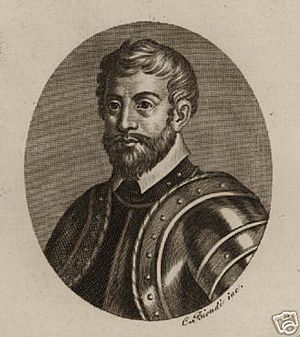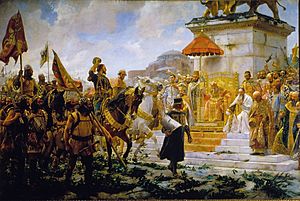Roger de Flor facts for kids
Quick facts for kids
Roger de Flor
|
|
|---|---|
 |
|
| Born | 1267 Brindisi, Kingdom of Sicily (modern-day Italy) |
| Died | 30 April 1305 (aged 37–38) Adrianople, Byzantine Empire (modern-day Edirne, Turkey) |
| Allegiance | Crown of Aragon Catalan Company |
| Years of service | 1282–1305 |
Roger de Flor (born in 1267, died April 30, 1305) was a famous Italian military adventurer. He was also known as Ruggero da Fiore or Rutger von Blum. Roger de Flor became a skilled leader in battles across Sicily, Italy, and the Byzantine Empire. He led a group of soldiers called the Great Catalan Company and was even given the title of Count of Malta.
Contents
Roger de Flor's Early Life and Adventures
From Sailor to Pirate
Roger de Flor was born in Brindisi, a city in the Kingdom of Sicily. His mother was an Italian noblewoman. His father, Richard von Blum, was a German falconer who worked for Emperor Frederick II. Sadly, Roger's father died in a battle in 1268.
When Roger was just eight years old, he began working on a ship. This ship belonged to the Knights Templar, a powerful group of warrior monks. He joined their order and eventually became the captain of a ship named "El falcó."
In 1291, during the siege of Acre, Roger helped rescue many wealthy people. After this, he moved to Cyprus. However, he faced some problems and was accused of wrongdoing. Because of this, he left the Knights Templar. Roger then went to Genoa, borrowed money, bought a new ship, and started a new life as a pirate.
Fighting for Sicily
At that time, there was a big war over who would control Sicily. The Aragonese kings and the French kings of Naples were fighting for the island. Roger de Flor was known as one of the best military leaders around. So, Frederick, the King of Sicily, asked Roger to join his side. Roger was given the important rank of vice-admiral.
The war ended in 1302 with a peace agreement called the Peace of Caltabellotta. After the war, King Frederick could no longer afford to pay his army. He wanted to get rid of the soldiers, known as "Almogavars," from Sicily.
Roger de Flor in the Byzantine Empire
Helping the Emperor
Roger de Flor saw a new chance to use his skills in the East. The Ottoman Turks were attacking the Byzantine Empire, causing a lot of damage. The Byzantine Emperor, Andronicus II Palaeologus, needed help.
Emperor Andronicus II offered Roger and his Almogavar army a job. In September 1302, Roger arrived in Constantinople with his fleet and about 6,500 soldiers. This group became known as the Catalan Company. The Emperor welcomed Roger, made him part of the imperial family, and gave him important titles. He married the Emperor's niece, Maria Asenina, and became a grand duke and commander-in-chief of the army.
Battles and Successes
After some initial challenges in Constantinople, Roger and his men were sent to Asia. Their mission was to fight the Ottoman Turks. They were very successful, pushing the Turks back far into the region.
After these victories, Roger and his army spent the winter in Cyzicus. In May 1304, they went back to battle. They defeated the Turks at Germe and helped save the important city of Philadelphia, which the Turks had surrounded.
Return to Europe and Tragic End
Later, Roger was called back to Europe. He placed his troops in towns like Gallipoli. He then went to Constantinople to ask for payment for his soldiers. In 1304 or 1305, Roger was given the high title of Caesar.
However, in April 1305, Roger de Flor was tragically killed in Adrianople. He was assassinated by the Emperor's son, Michael. The Catalan Company later took revenge for Roger's death. They plundered lands from Macedonia to Thrace in what became known as the "Catalan Vengeance."
Roger de Flor's Legacy
Stories and Books
The early adventures of the Catalan Company were written down by Ramon Muntaner, who was a member of the company himself. His book is called Crònica.
Roger de Flor's life also inspired a famous fictional character. This character is Tirant lo Blanc, from an epic story written by Joanot Martorell in 1490. This book is one of the most important medieval stories in the Catalan language. It even influenced famous writers like Miguel de Cervantes.
Roger de Flor is also a main character in The Horsemen of Death, a historical novel by Estonian writer Karl Ristikivi. A Greek writer, Kostas Kyriazis, also wrote a historical novel with Roger de Flor as the main character.
Music and Military Honors
A Spanish poet named Mariano Capdepón wrote a play about Roger's last days. A composer named Ruperto Chapí then used this play to create his opera, Roger de Flor, in 1878.
Today, one of the units in the Paratrooper Brigade of Spain is named after Roger de Flor. This shows how important he remains in history.
See also
 In Spanish: Roger de Flor para niños
In Spanish: Roger de Flor para niños


